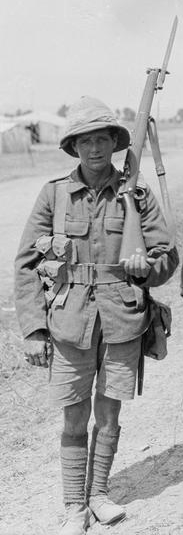Monday April 8th, 1918
No parade this morning, rained very hard. Fell in for work 2 o’clock but rained off. Finished for the day. Hard raining night.
Khaki Exchange
Today it is raining so hard that building and renovation work in the trenches has to be called off. Therefore it seems a little premature for the Battalion Diary to be publishing today its schedule for moving from winter to summer clothing and kit.
Only the British Army dressed its troops in camouflage uniforms at the beginning of the war, though others quickly followed suit. Today camouflage equipment is much more sophisticated but then it was just a matter of the colour – known as drab or khaki. Ironically in 1914, the British Army used to buy its khaki-coloured dye from the Germans.
Khaki had been used since the mid-19th century by the Indian Army. It became standard issue, in a slightly darker shade, for all troops in 1902. The Service Dress (SD), including the jacket, trousers, cap, puttees (wrappings for the calf and lower leg) and great coats, were made of wool serge. According to today’s Battalion Diary – even their winter drawers were made of wool. This recruitment poster showcases much of the Tommy’s uniform and kit.*
The officers had to buy their own uniforms. Recognizing the expense of this, and that increasingly temporary officers were coming from many backgrounds, the Army introduced an allowance to help. However this flexibility granted to officers to select their own uniforms allowed them to secure more practical clothing. It was therefore for officers only that the famous ‘trench coat’, made from waterproofed gabardine, became a staple of WWI.

The Tommies had to make do with the wool greatcoat which, while warm, could be very uncomfortable and heavy in wet and muddy conditions. None of their woolen clothing was waterproof – as evidenced by the winter issue of waterproof covers for their caps which are to be handed in later this month.
Khaki Drill (KD) will be issued for summer. It is a light weight fabric and made up in different patterns of Service Dress, often including shorts and the ubiquitous Wolseley pattern cork helmets.
This photograph shows the uniform that Frank and his comrades will be issued with later this month. It is a clip from a larger photograph from the Imperial War Museums’ collection. It was taken in 1916 on the Dojran Front, and shows the standard uniform of a BSF infantryman in tropical or warmer climes.
After the largesse a couple of days ago in respect of extra Lewis Guns, wagons and carts, the Battalion, while in reserve, is to hand in a variety of axes, picks and shovels. I am sure Frank will be happy to see them go.
13th (Service) Battalion War Diary – 8th April 1918 – Saida
Work and training as per programme (App No 2) Winter Clothing will be handed in as stated below:- 2nd winter blanket 30-4-18, Covers WP Cap, 13-4-18. Mufflers 20-4-18, Gloves, worsted, 30-4-18, Boots FSM 13-4-18, Soles, inner 13-4-18, Rugs, horse 25-4-18. Drawers woolen – when drawers, cotton are available. Jackets SD – when summer jackets are available, Trousers SD – when trousers KD are issued. The amended Mobilization Establishment of tools is as follows:-
A) each Coy (exclusive of picks and shovels carried by the Lewis Gun Section) Axes hand 1, Axes felling 2, Bags IT 2, Bill Hooks and Rasping Hooks 2, Picks 10, Shovels 10. To be always in possession of Coys and carried on animal allowed for tools.
B) Battalion Reserves (carried in Limber for tools). To be returned to QM Stores from each Coy by the 10th inst. Bags IT 2, Crow Bars 1, Axes hand 1, Axes felling 3, Bill Hooks 5, Rasping Hooks 3, Picks 8, Shovels 12, HQ Coy to return Bags IT 2, Picks 10, Shovels 10, Crow Bars 1.
References & Further Reading
¹ 10 things you (probably) didn’t know about WWI uniforms by Jane Tynan in History Extra
* poster from The Uniform and Equipment of 1914 article on the National Army Museum, London website
³ Khaki Drill in Wikipedia
^ photograph of BSF infantryman in Khaki Drill 1916, clipped from Q 32231 of IWM



